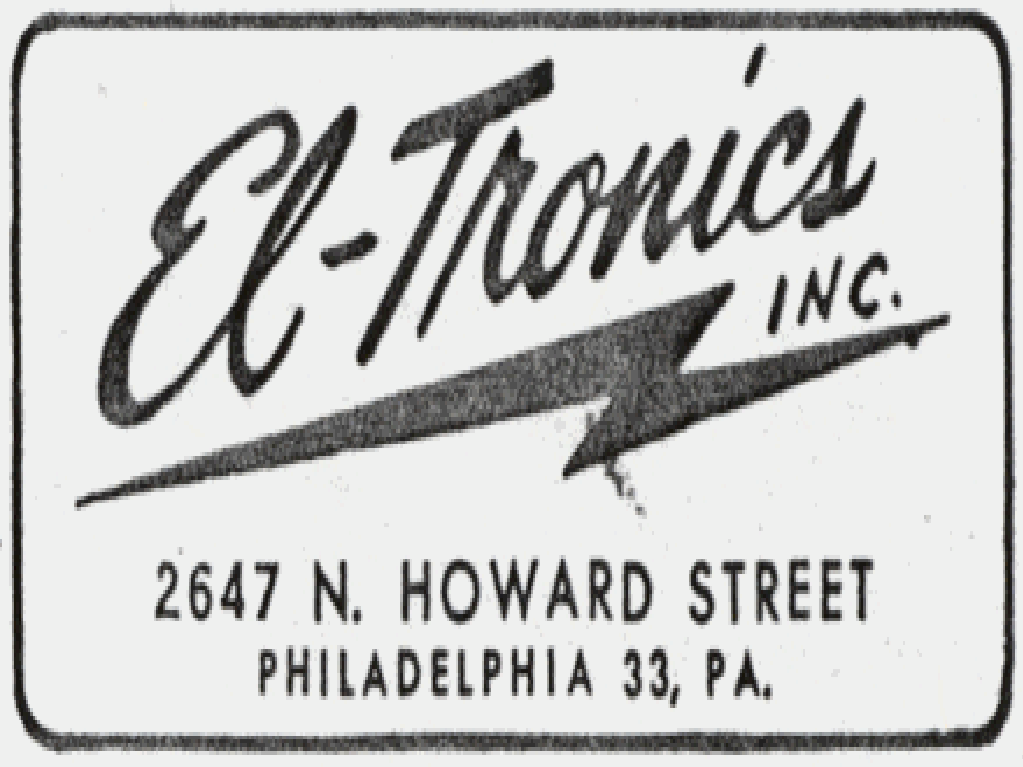
El-Tronics
El-Tronics was located at 1920 Lincoln-Liberty Building in Philadelphia, PA in 1948 and began selling Geiger counters in the late 1940's. They advertised as “Designers and Manufacturers of Nucleonic and Electronic Equipment”. They later moved to 2647-67 North Howard Street and then in early 1955 to Fifth and Noble Streets, Philadelphia, PA. Later in 1955, the company was located at 1420 Walnut Street. They claimed to be manufacturers of GM counter apparatus for nearly 14 years in 1948.

El-Tronics Logo

El-Tronics Letterhead 1955

El-Tronics Model LS-1 Ad 1948
The Model RS-3 was a portable beta gamma count rate survey meter offered in 1948. It had a GM tube in an external probe. The unit weighed 12 lbs. The full scale was 0.25, 2.5 and 25 mR/h. It used 1.5, 3 and 45 volt batteries with a lifetime of 34 hours.
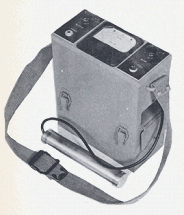
El-Tronics Model RS-3 1948
The Model SM-3 (AN/PDR-26) and SM-3A were introduced in 1948. It was a replacement or the RS-3. It was advertised as “The Last Word in Geiger Muller Portable Survey Instruments”. It was a portable, battery-operated survey meter for detecting both gamma and beta radiation. It incorporates new features and is small, compact, waterproof and weighs only 8.75 lbs. The unit measures 9.25” x 4.5” x 6”. It is housed in a waterproof and fungus proof aluminum case. There are three range selections from 0.2 to 20 mR/h with a large three-inch panel meter. The probe is a thin walled tube used for sensitive beta measurements. The GM tube was filled with neon and ethyl ether and contains a sliding beta shield. The wall thickness allows 25% of the beta radiation for betas up to 350 keV. Operating life is 200 hours with 1.5, 45 and 300 volt batteries. It sold for $225 in 1948.
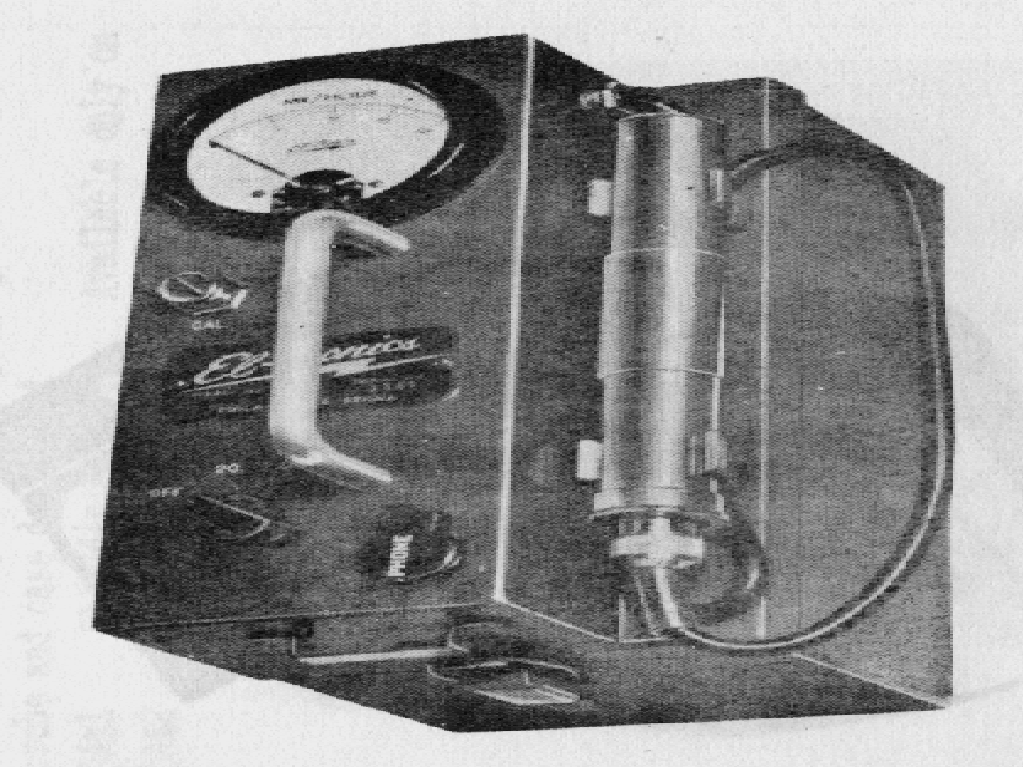
El-Tronics Model SM-3 1948
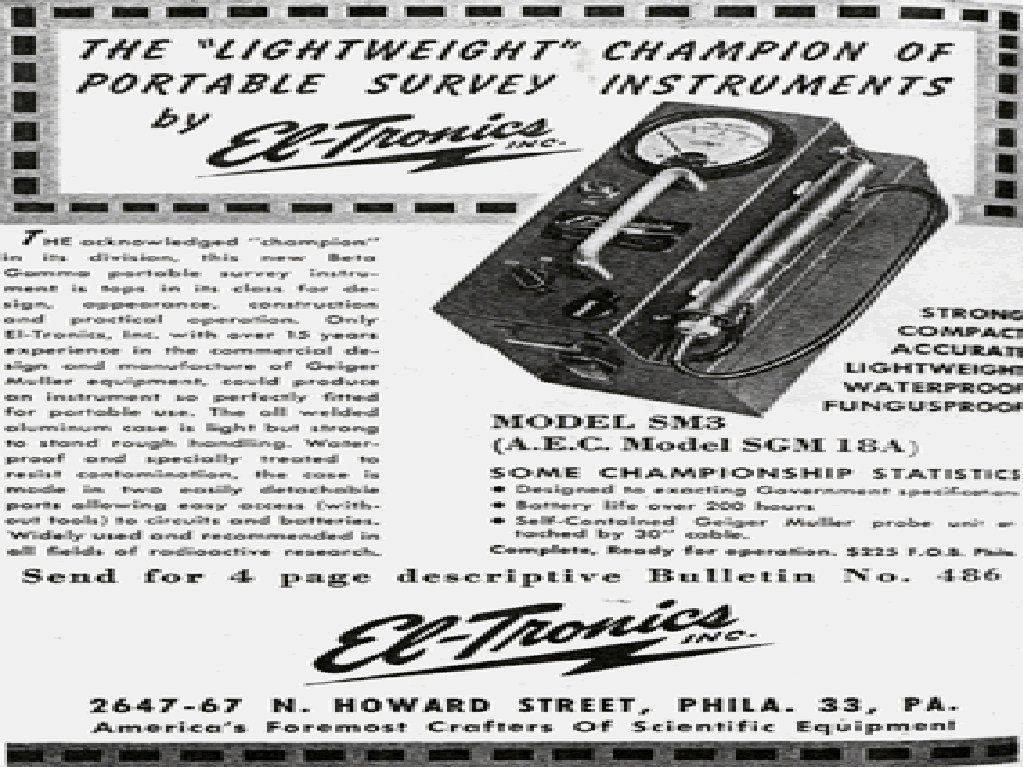
El-Tronics Model SM-3 Ad 1949
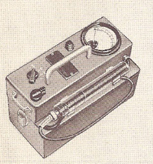
El-Tronics Model SM-3 1951
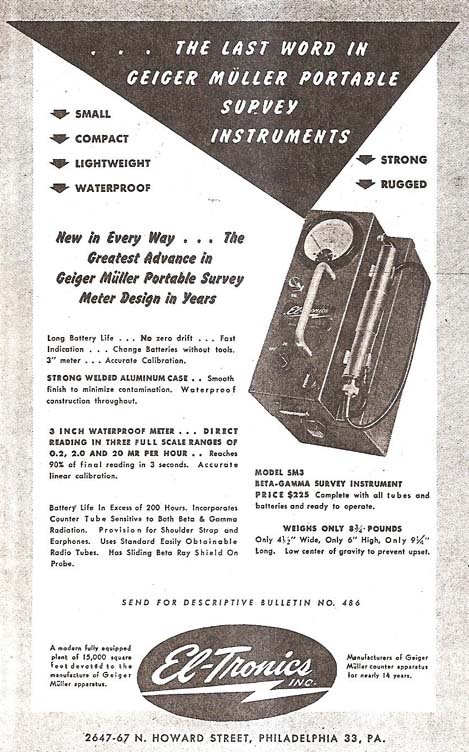
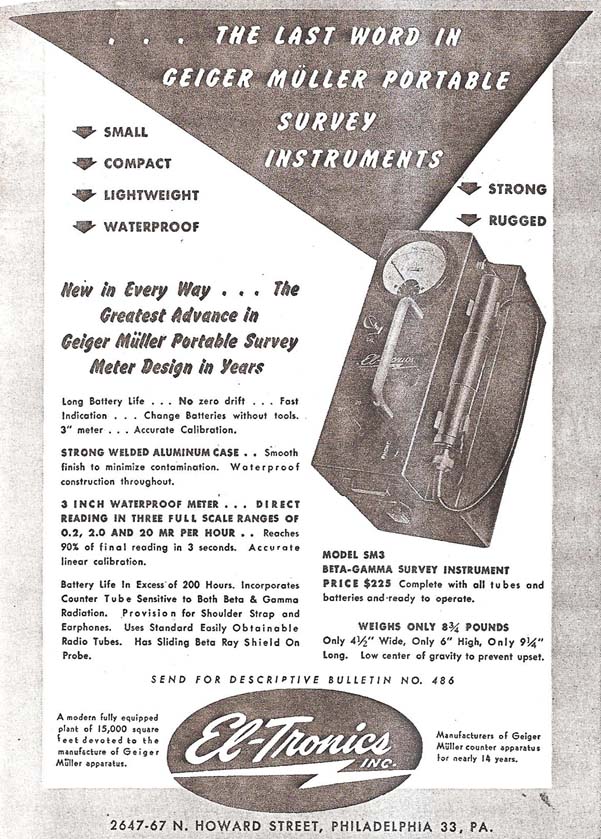
El-Tronics Model SM-3 Ads 1948 (left) and 1949 (right)
The Model SM-3 series was introduced in 1949. The Model SM-3 from 1953 offered three ranges of 0.2, 2 and 20 mR/h. It had a 3” diameter scale and an earphone jack. It was made of welded aluminum with baked enamel finish. The unit was 9-1/4” long and weighed 8-3/4 lbs. A 30” cable connects the counter tube. It uses one 1.5, two B, and a bank of three 300 volt batteries. It sold for $195 in 1953.
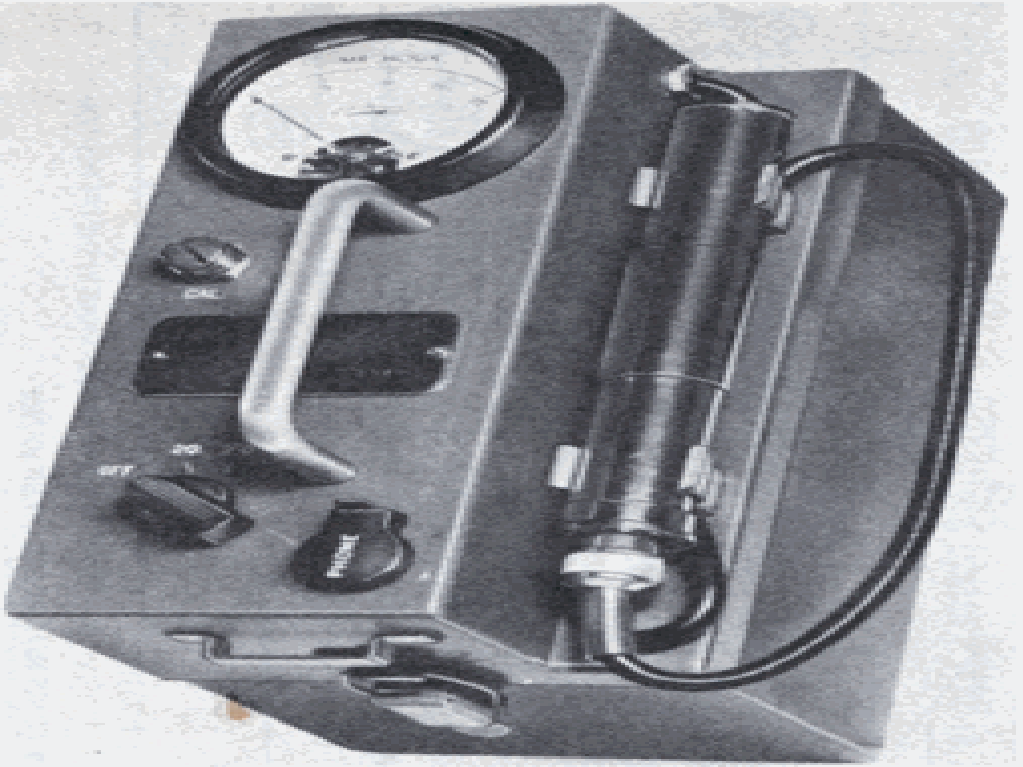
El-Tronics Model SM-3A 1949
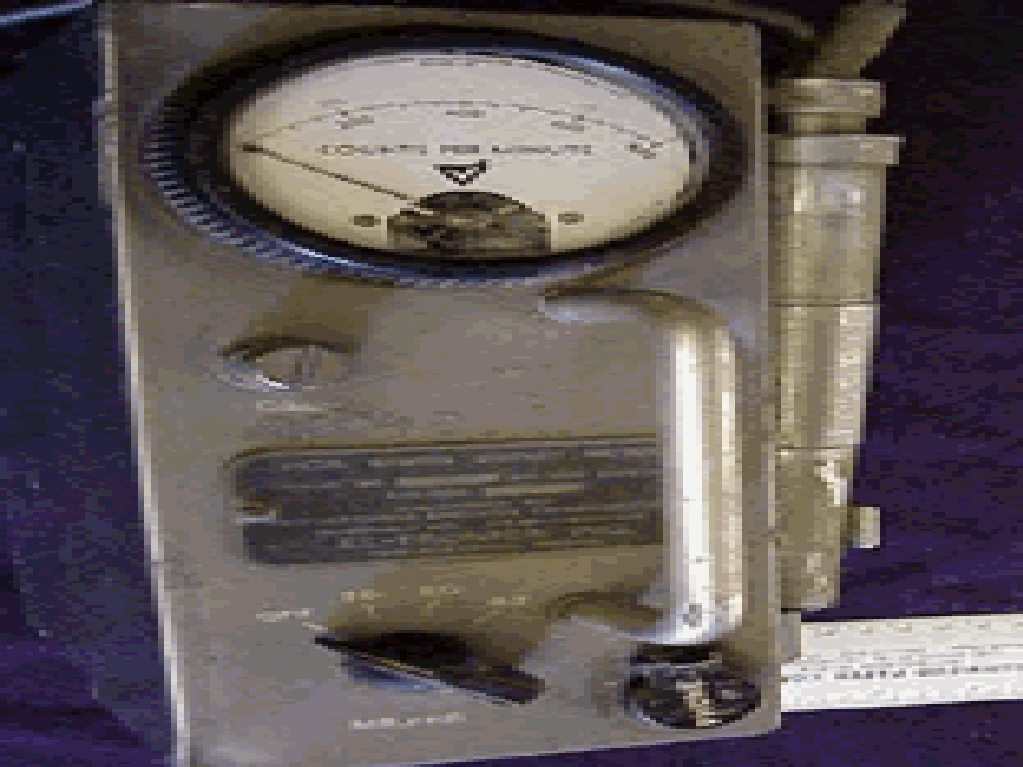
El-Tronics Model 193
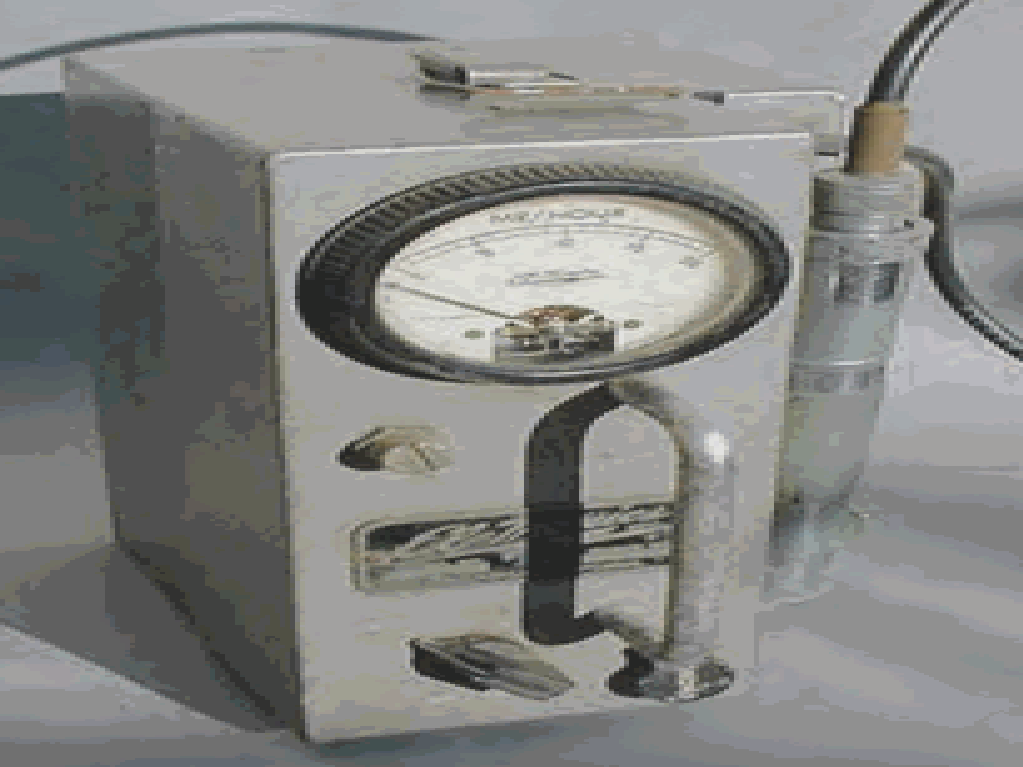
El-Tronics Model SGM-18A
The Model DS-7 was introduced in 1950 as a classroom demonstrator for radioactivity detection. It was 9-1/8” x 6-7/8” x 8-3/4” and weighed 15.5 lbs. It could be used with beta or gamma tubes. It operated on AC. A radioactive gamma sample was supplied. It has audio and flashing neon visual indicators. It sold for $69.50 in 1953. A gamma counter tube could be added for $15
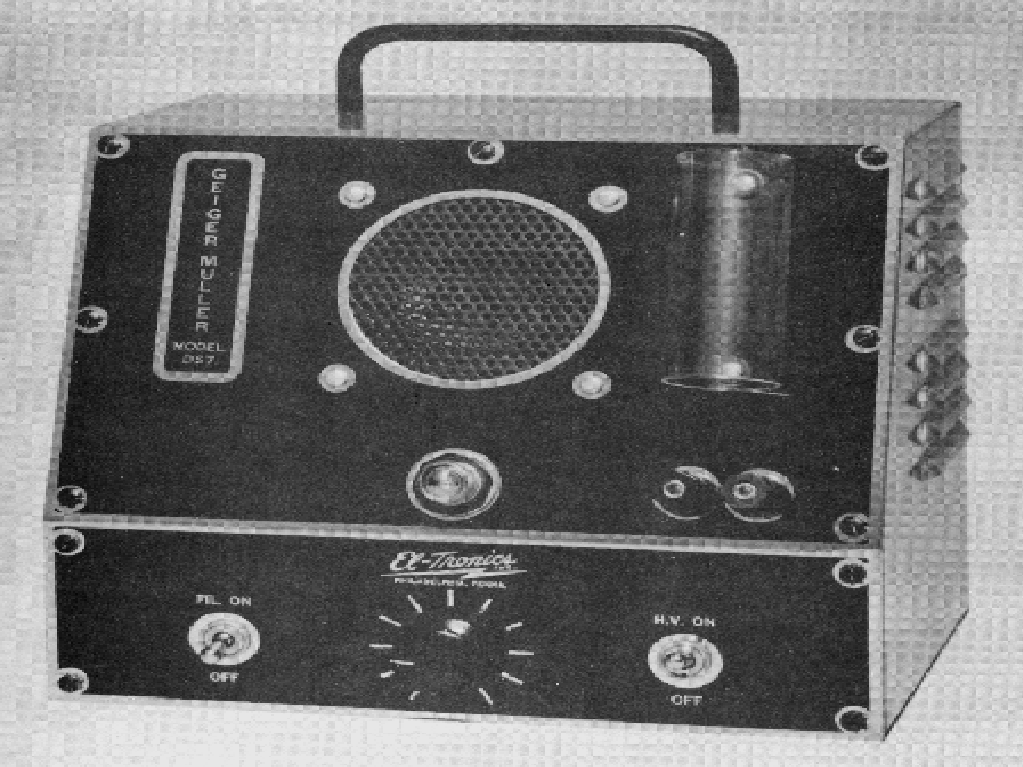
El-Tronics Model DS-7 1950-1953
One of the El-Tronics most basic units was the pocket Geiger counter Model PR-1 which sold for $21.95 in 1955. It was a pocket sized Geiger counter for uranium prospecting.
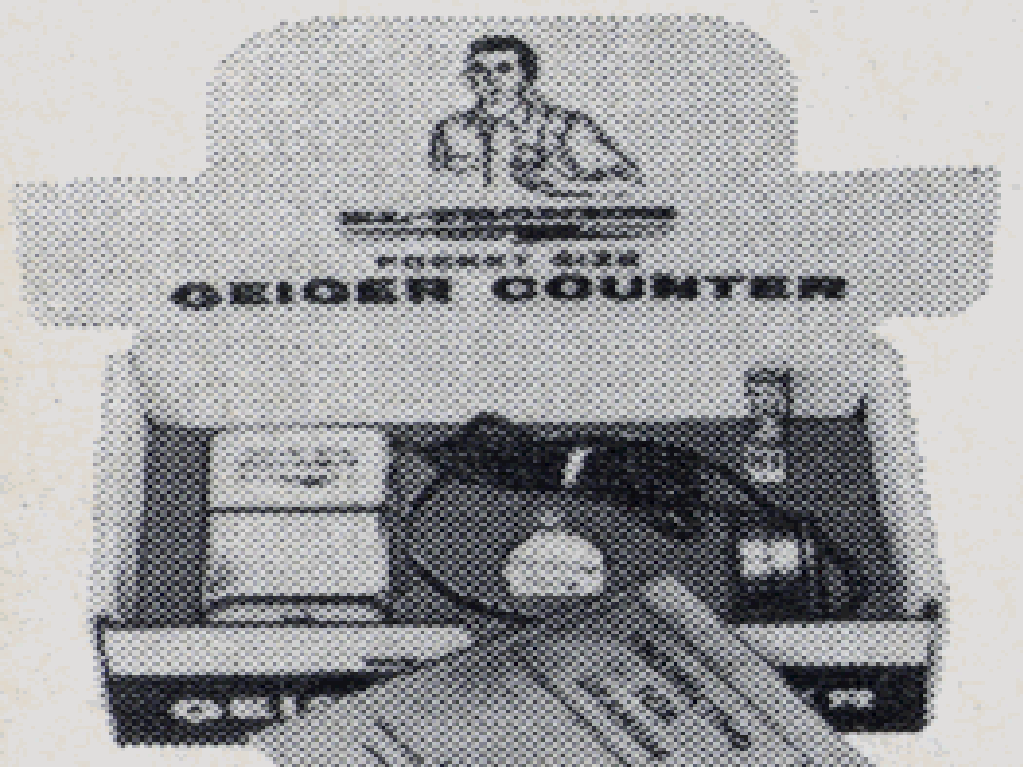
El-Tronics Pocket Geiger PR-1
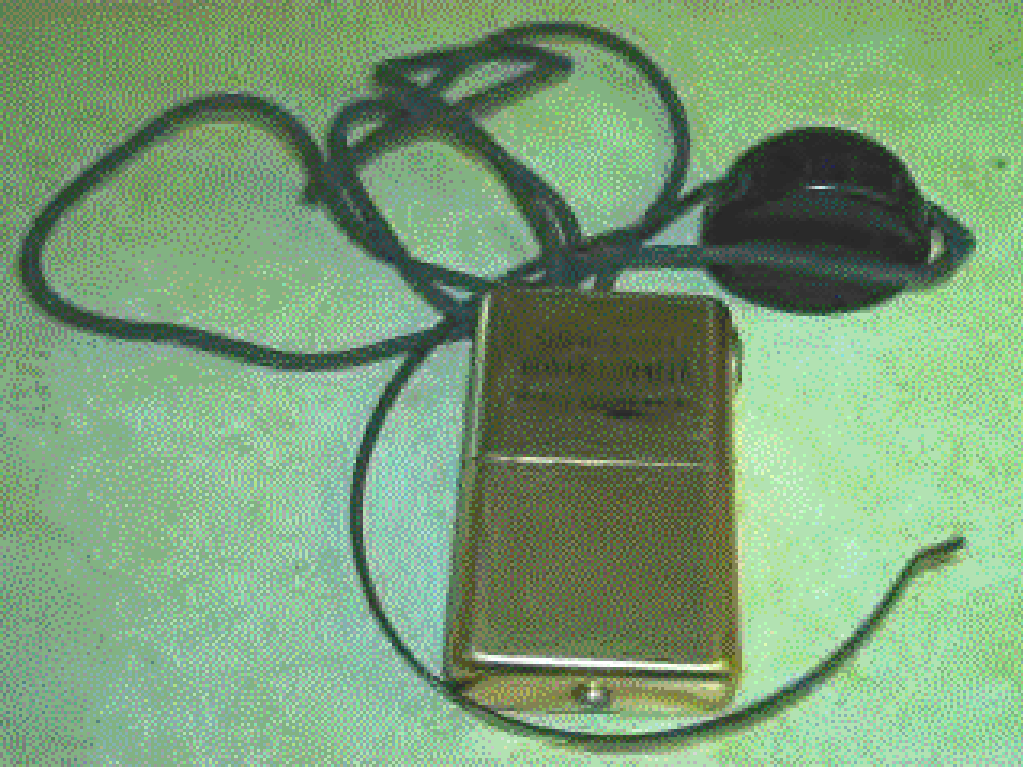
El-Tronics Model PR-1 1955
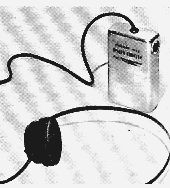
El-Tronics Model PR-1 1955
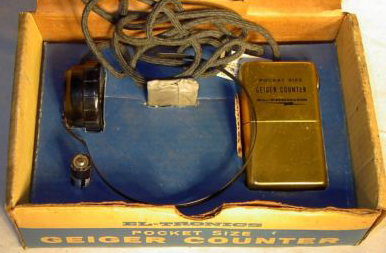
El-Tronics Model PR-1
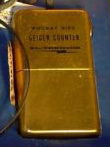
El-Tronics Model PR-1
El-Tronics manufactured the Ura-Finder Model PR-2 for $39 in 1955. It was described as a quality product in the low price range for portable prospecting equipment. It was very compact and designed specifically for uranium prospecting. It was 1-1/8” x 2-5/16” x 4” and weighed 1.5 lbs. The unit was sold with a hearing aid type earpiece instead of headphones. The unit was designed to fit in a case and be clipped to your belt. Battery was by a single penlight battery. The unit came with a uranium ore sample for testing. When you push the button, current flows through the relay to the primary of the transformer. The transformer secondary provides the stepped up voltage for the Geiger tube.
Each interaction in the Geiger counter produces a click in the earphones. The rate of clicking is a direct indication of the radiation intensity. For background, the unit will operate for a long period of time. When the counting rate is high, the capacitor will discharge more rapidly. It uses a halogen-quenched Geiger tube. The overall tube enclosure is glass with a thin stainless steel shell as the inner electrode. Betas are screened by the glass and steel and thus permit detection of only gammas. It is ideal for taking on hikes and camping trips where weight is a concern.
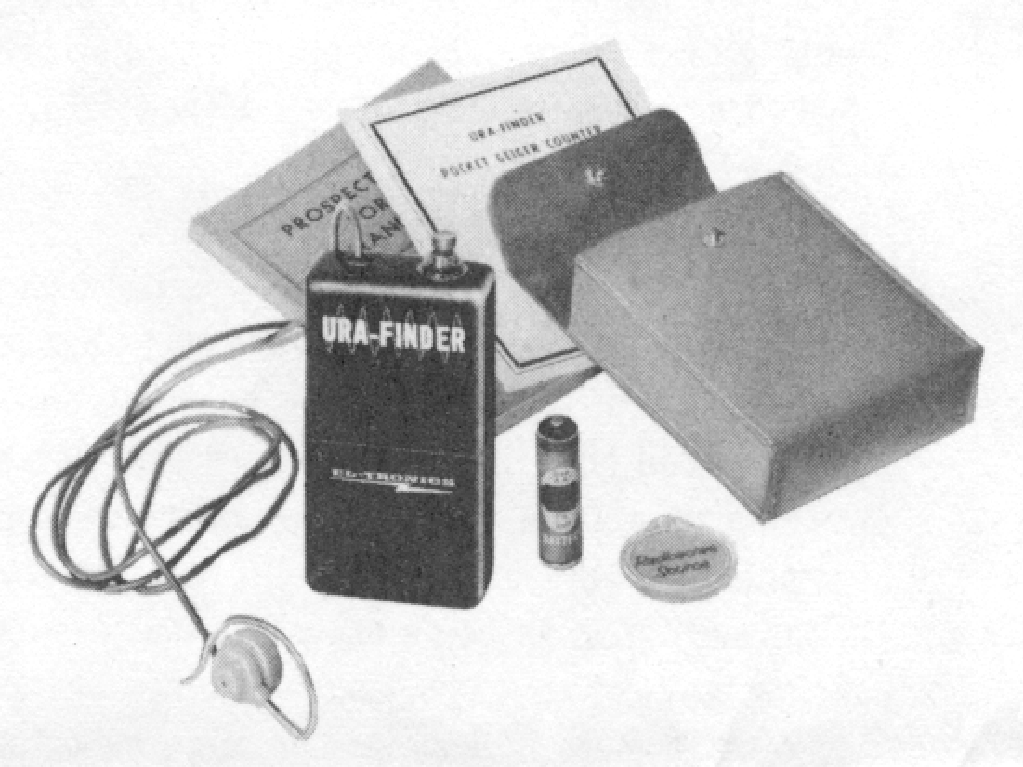
El-Tronics Model PR-2 1948
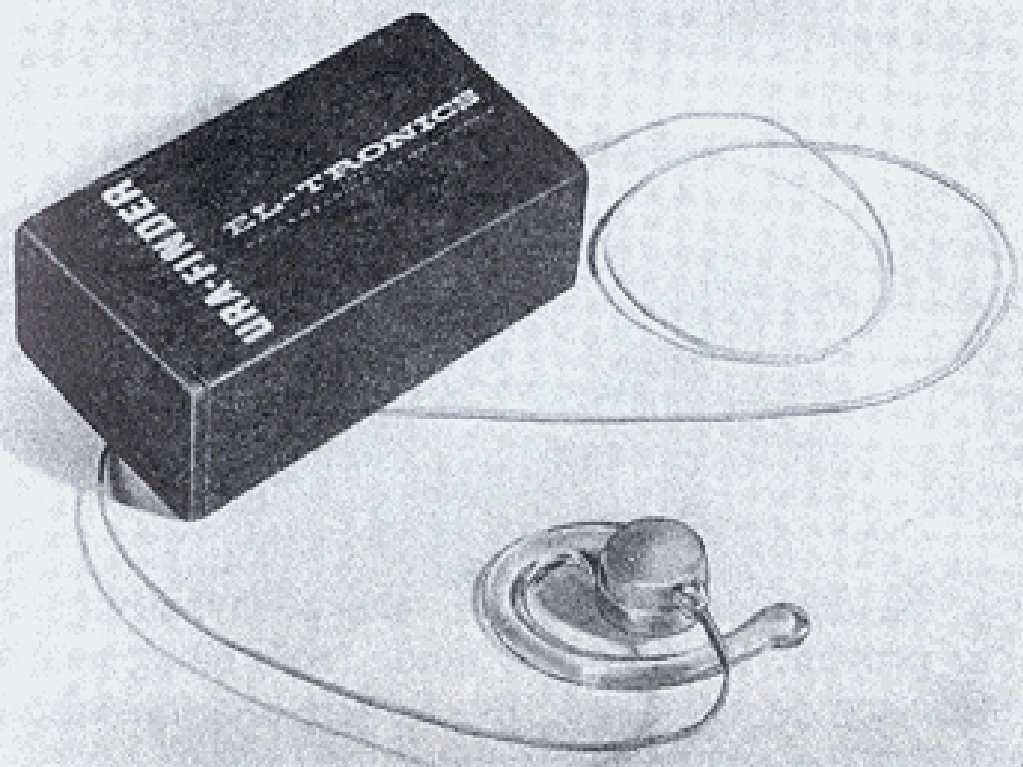
El-Tronics Ura Finder PR-2 1950's
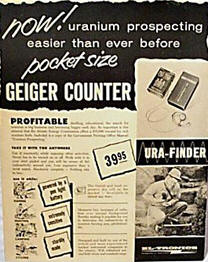
El-Tronics Ura-Finder Ad 1950's
The Model PR-2 (AN/PDR-T-1) was offered in 1948 as a GM survey meter for the military. After evaluations at Operation Sandstone, the unit was developed as a training instrument. The unit was 10” x 6” x 7” and weighed 9.5 lbs. The probe length was 36”. It had a range from 0.5, 5 and 50 mR/h. It had a push button for scale illumination.
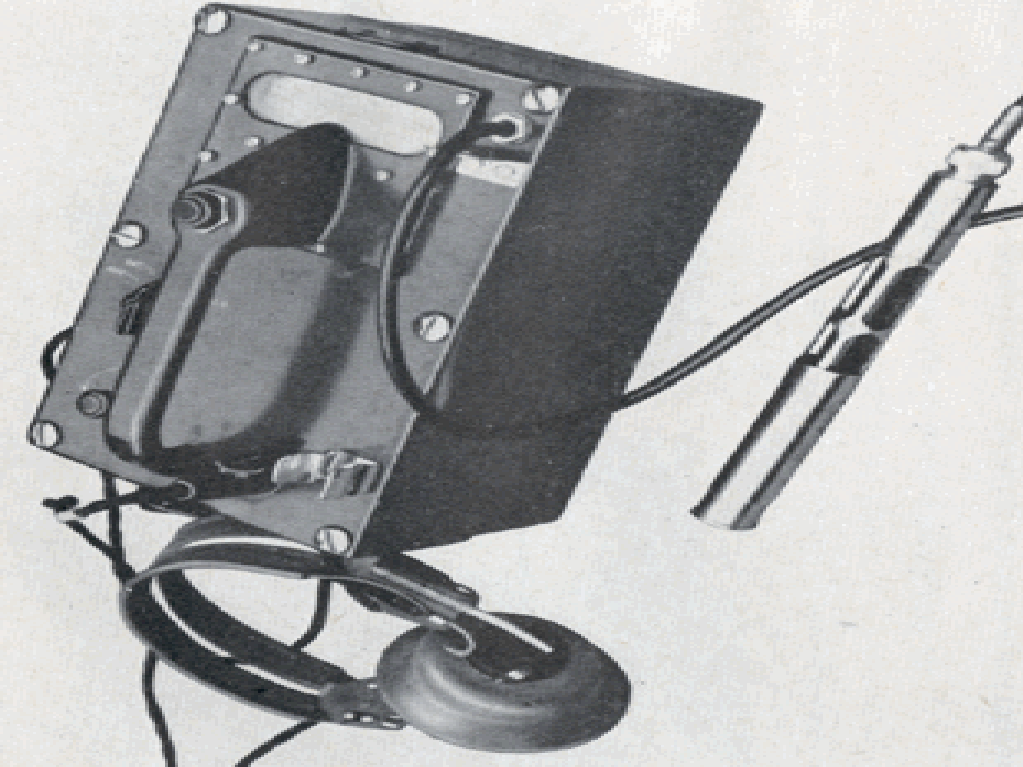
El-Tronics PR-2 1951
The PR-3 is a portable survey meter introduced in 1950. It was the deluxe version of the Model SM-3. It used a new, improved large size Navy type sliding scale meter, where each scale has a distinctive color to prevent misreading. It had a thin wall GM tube for beta gamma detection. It measured 5.25”x9.5”x6.5” and weighed 8.5 lbs. The sensitivity was 0.2, 2 and 20 mR/h and all were denoted in different colors. It featured a vibrator power supply which operates on two 1.5 volt low cost batteries, had a vari-colored sliding select-o-scale meter, a lighter improved rotating beta shield, and improved aluminum case. The unit was shower proofed and fungus proof. It sold for $225 in 1950.
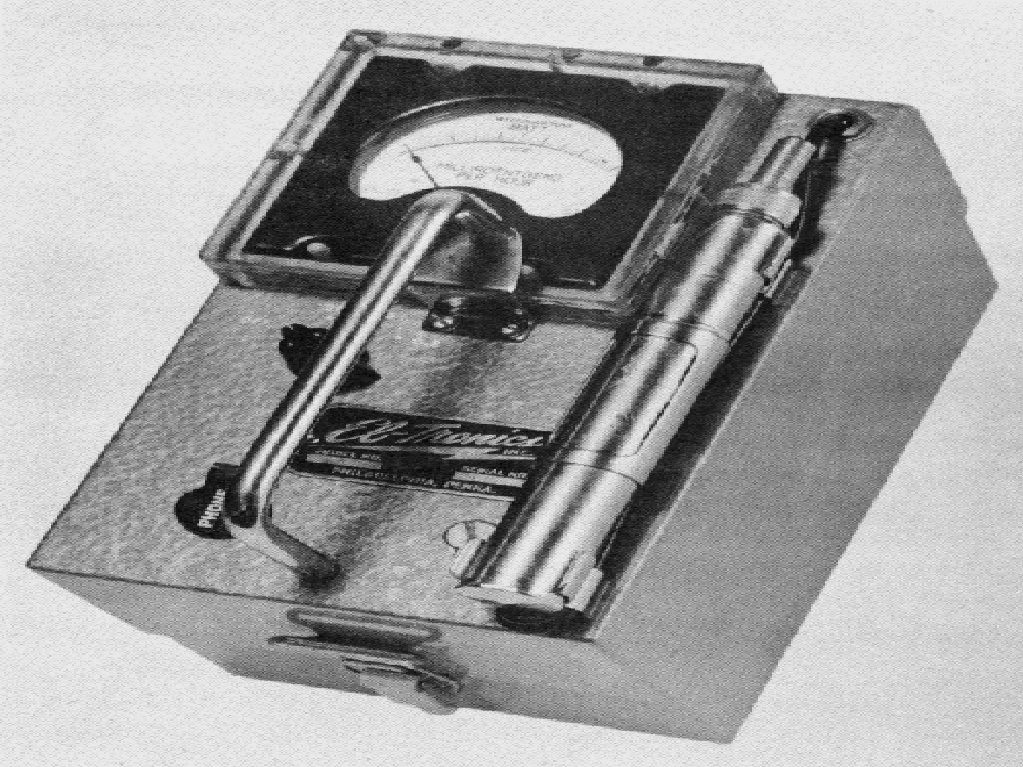
El-Tronics Model PR-3 1950
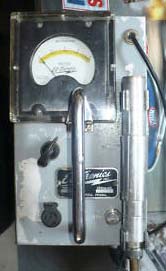
El-Tronics Model PR-3 1950's
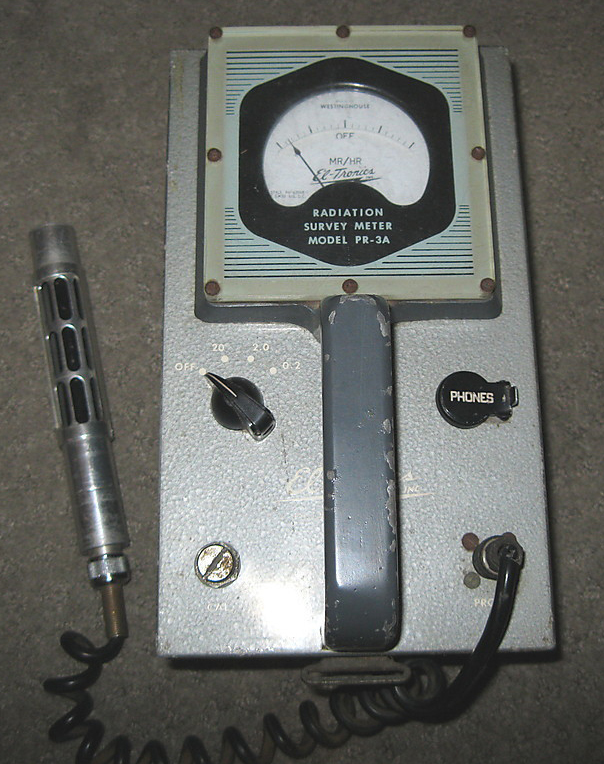
El-Tronics Model PR-3A 1950's
The Model AN/PDR-T2W was offered in 1949 as a portable, beta-gamma count rate meter. It had an external, thin wall GM tube. It weighed less than 8.5 lbs. The full scale sensitivity was 0.5, 5 and 50 mR/h. It used the three color scales. The meter could be illuminated for night operation. It could be used with headphones.
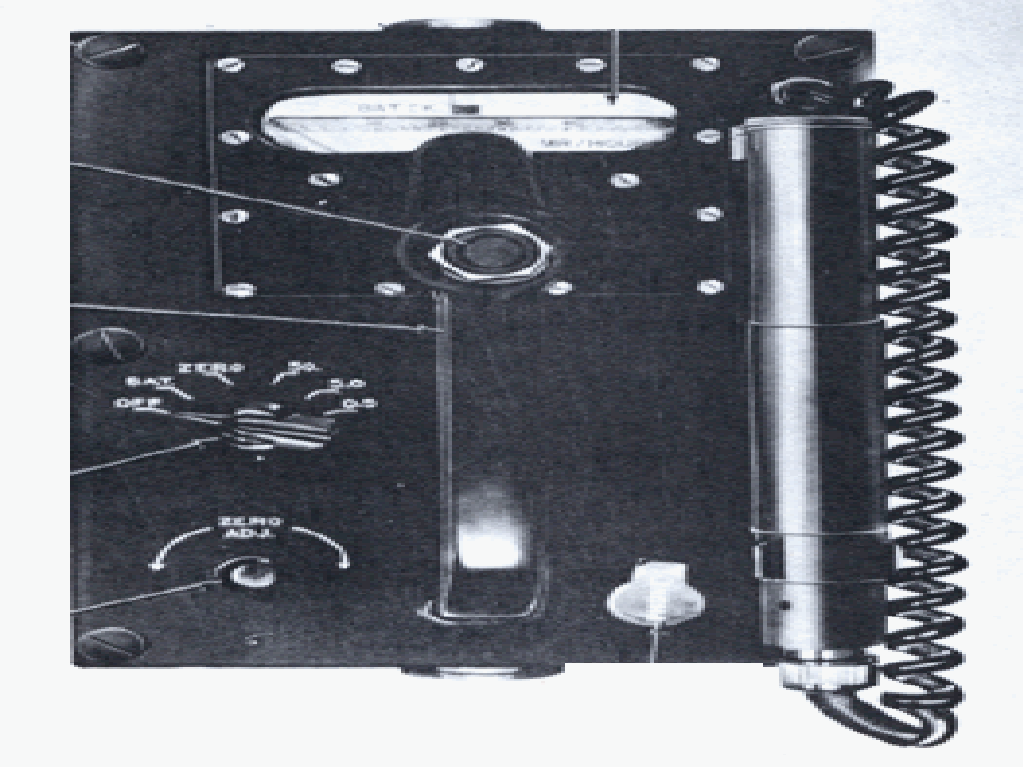
El-Tronics Model AN/PDR-T2W 1949
The El-Tronics “Eldorado” Model PR-4 was offered in 1955 for uranium prospecting. It had headphones and a neon flasher. It used ordinary flashlight batteries. The case contains a beta window for extra sensitivity. The unit was carried with a shoulder strap. The unit measures 1-3/4” x 7” and weighs 4 lbs. 6 oz. It sold for $49.95 in 1955.

El-Tronics Eldorado Model PR-4 1955
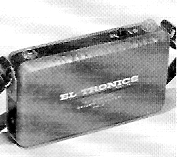
El-Tronics Eldorado Model PR-4 1955
El-Tronics produced a full-page ad in magazines such as Popular Electronics in 1955 showcasing their product line. El-Tronics offered a wide array of Geiger counters and scintillation counters for uranium prospecting, laboratory, civil defense and military use. The ad was from the Uranium Prospectors Supply Company in Philadelphia, Pennsylvania.
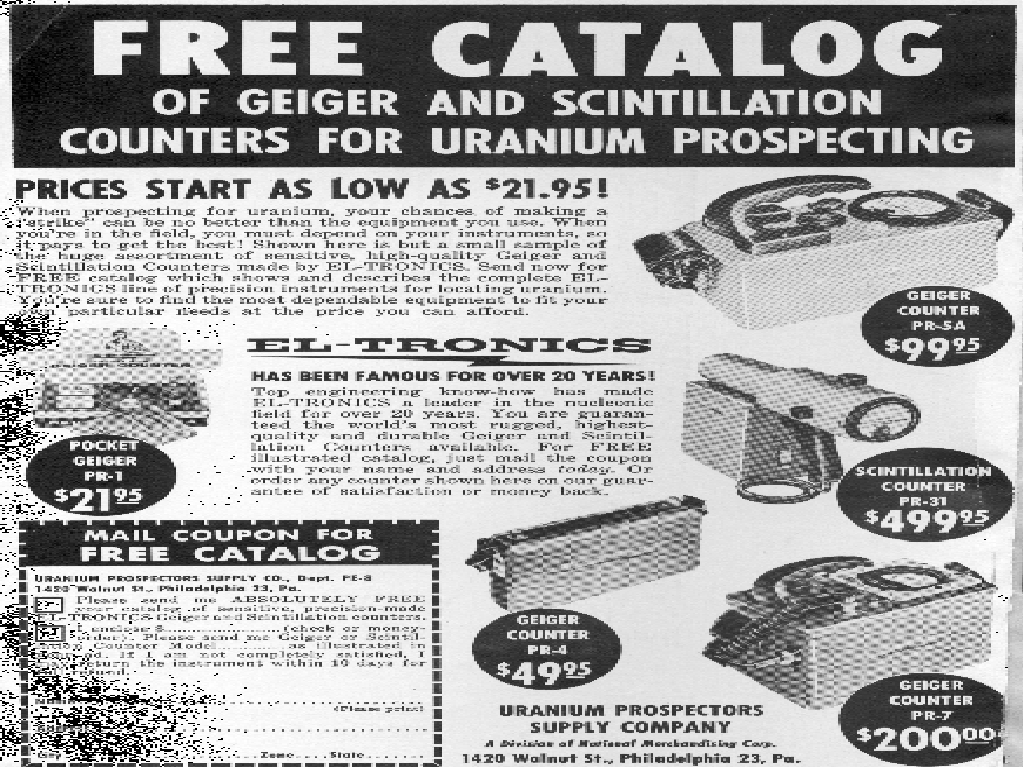
Popular Science El-Tronics Ad 1955
El-Tronics also produced the Three-Range Counter Geiger Counter Model PR-5A for $99.95 in 1955. It has a built in GM tube (halogen quenched). It was powered by two flashlight batteries. The unit weighed about 7 lbs. The meter ranges were 0.2, 2.0 and 20 mR/h. It had a curved handle on top. The unit could be used with headphones or neon flasher and had a waterproof meter. It had a hammertone finish and a drawn aluminum case. The unit measured 3-3/4” x 3-3/4” x 7-7/8” and weighs 4-7/8 lbs.
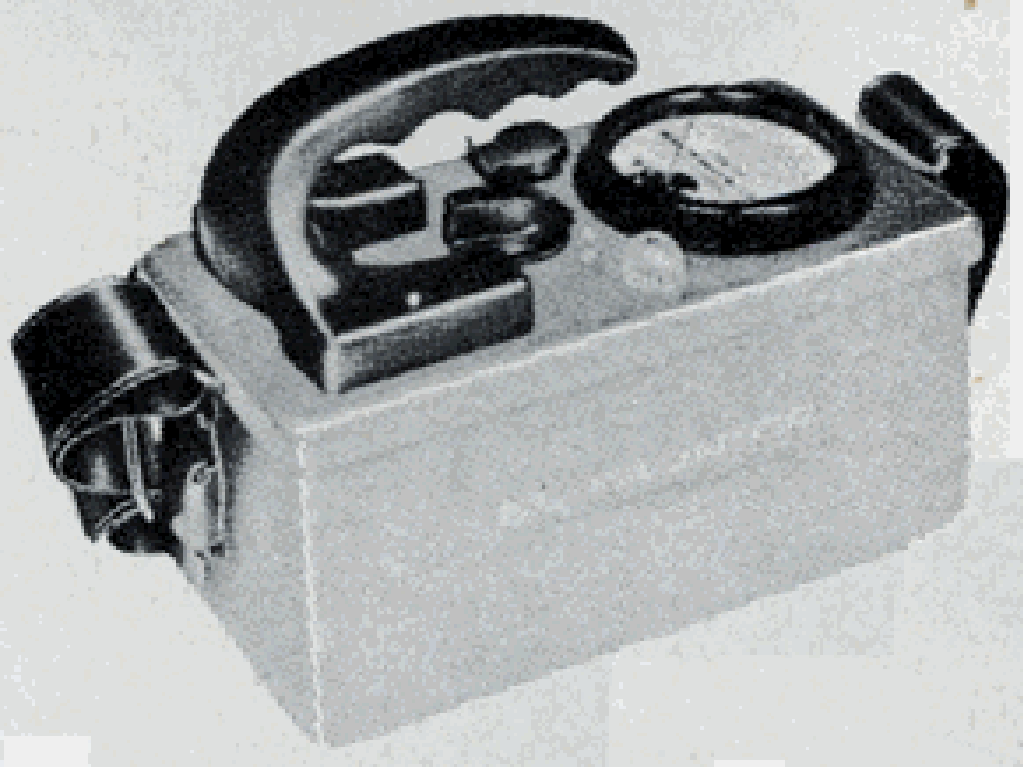
El-Tronics Model PR-5A 1955
El-Tronics produced the Model PR-6 in 1955 for $159.95. It was a military type Geiger counter built to military ruggedized specifications, waterproof and tropicalized. It required two 67-1/2 volt B batteries. The batteries would last hundreds of hours. It has three scales 0.2, 2.0, and 20 mR/h. It uses one 1.5 and two 67.5 volt batteries. An external probe fits into the back case housing to avoid damage when not being used. It could be used with the WLP-2 well logger probe that came with 50 feet of cable and sold for $129.95. The WLP-3 well logger probe was similar to the WLP-2 but did not have an amplifier.
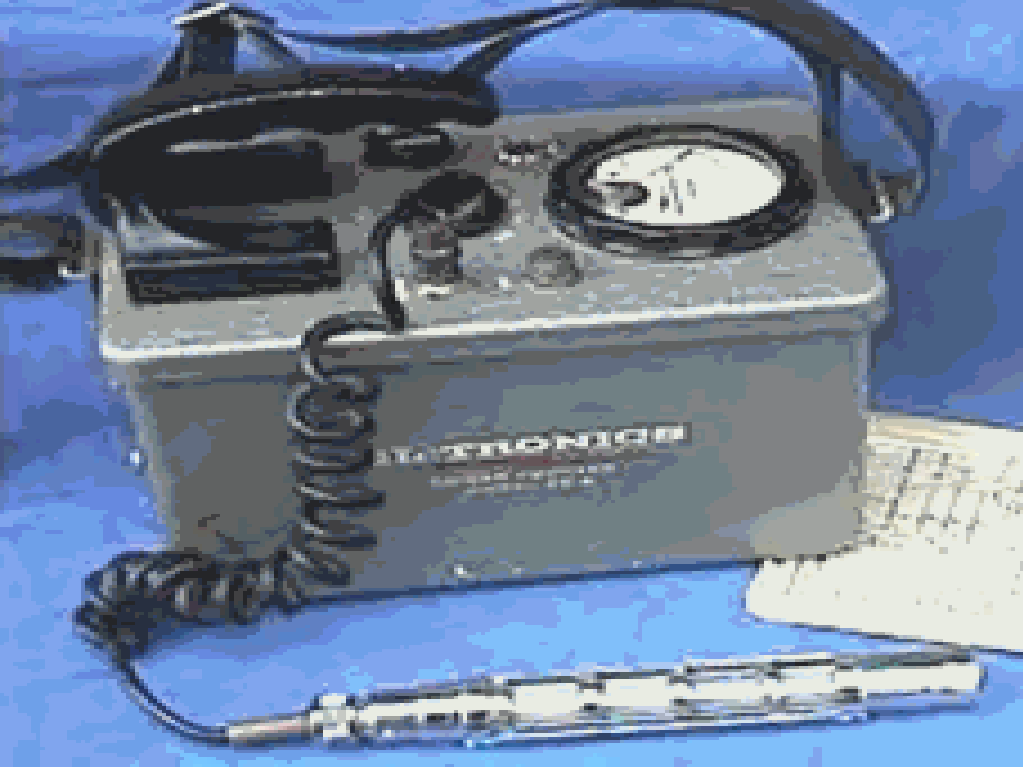
El-Tronics Model PR-6 1955
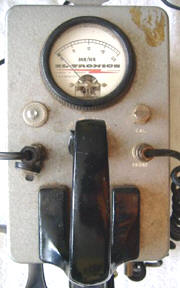
El-Tronics Model PR-6 1950's
The Model PR-7 was similar to the PR-6 and sold for $200. It has a scale change meter which give colors of green for 0.2 mR/h, yellow for 2 mR/h, and red for 20 mR/h. It has a external detachable probe. It measured 5-7/8” x 8-1/4” x 5-1/4” and weighed 10 lbs.
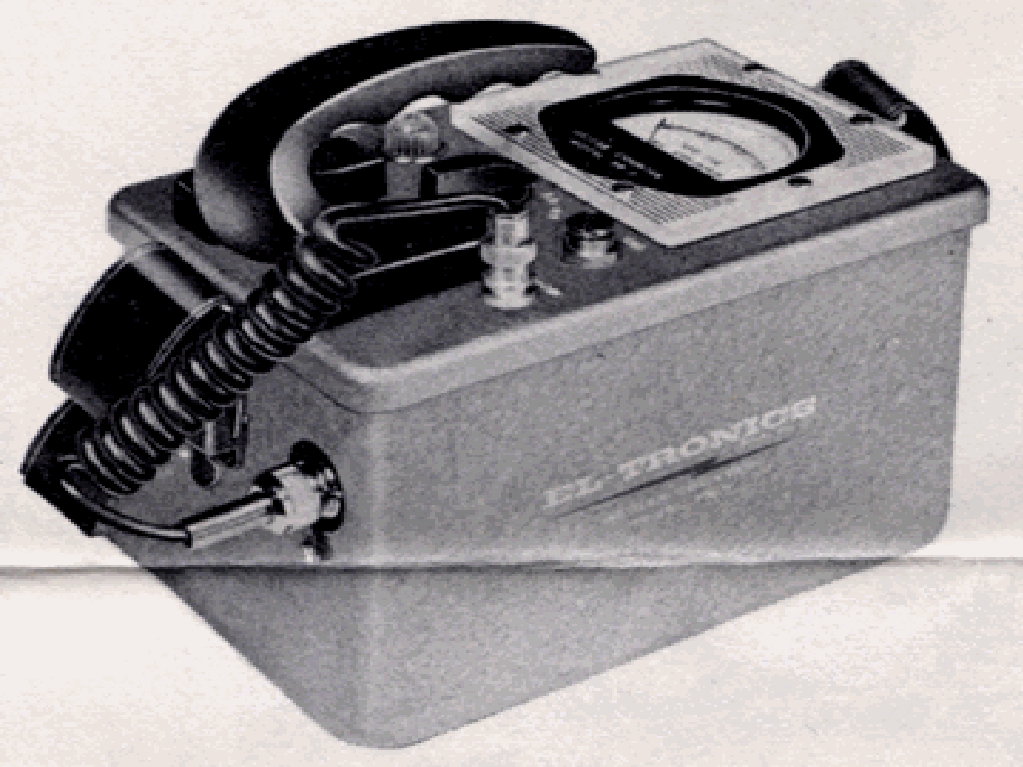
El-Tronics Model PR-7 1955
The Model PR-30 Scintillation Counter was introduced in 1955 a military-type meter. It was sturdy, shock resistant and watertight. It has a large 2.5” meter and a neon flasher. It has a 9 position switch, a fast-slow time constant, and background zero adjust. The detector was a large 1” x 1” sodium iodide crystal. It uses one 1.5 and two 67.5 volt batteries. The range is extended to 20 mR/h and can measure down to 0.02 mR/h. It weighs 8 lbs. 14 oz. and sold for $349.95.
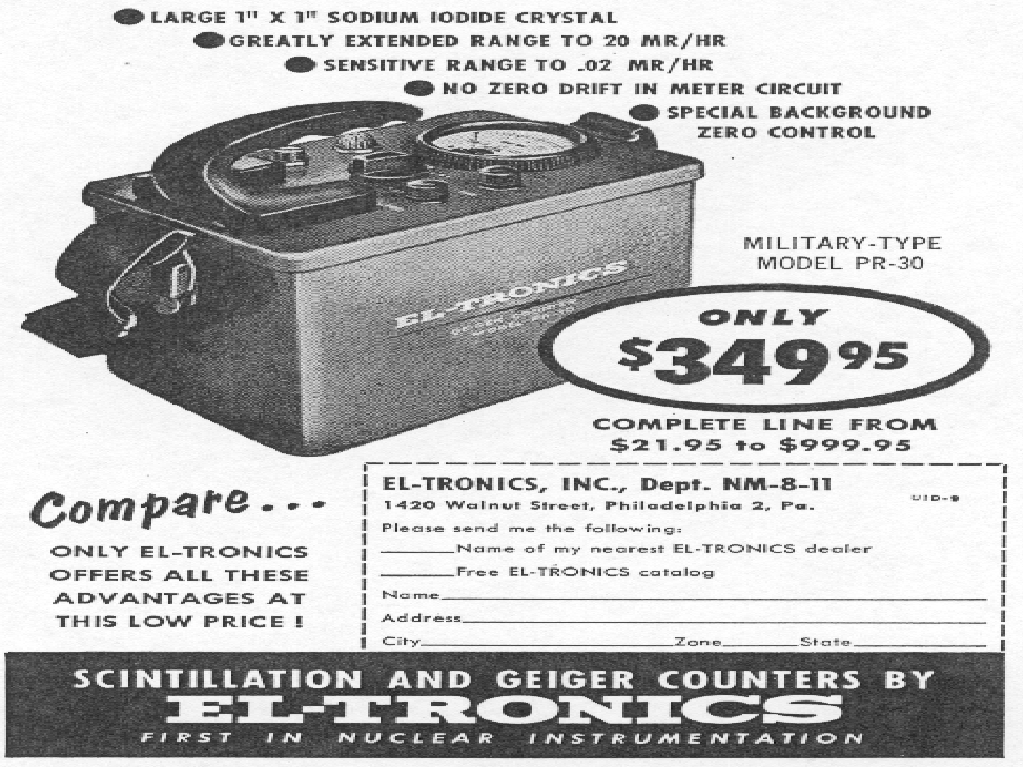
El-Tronics Model PR-30 Ad 1955
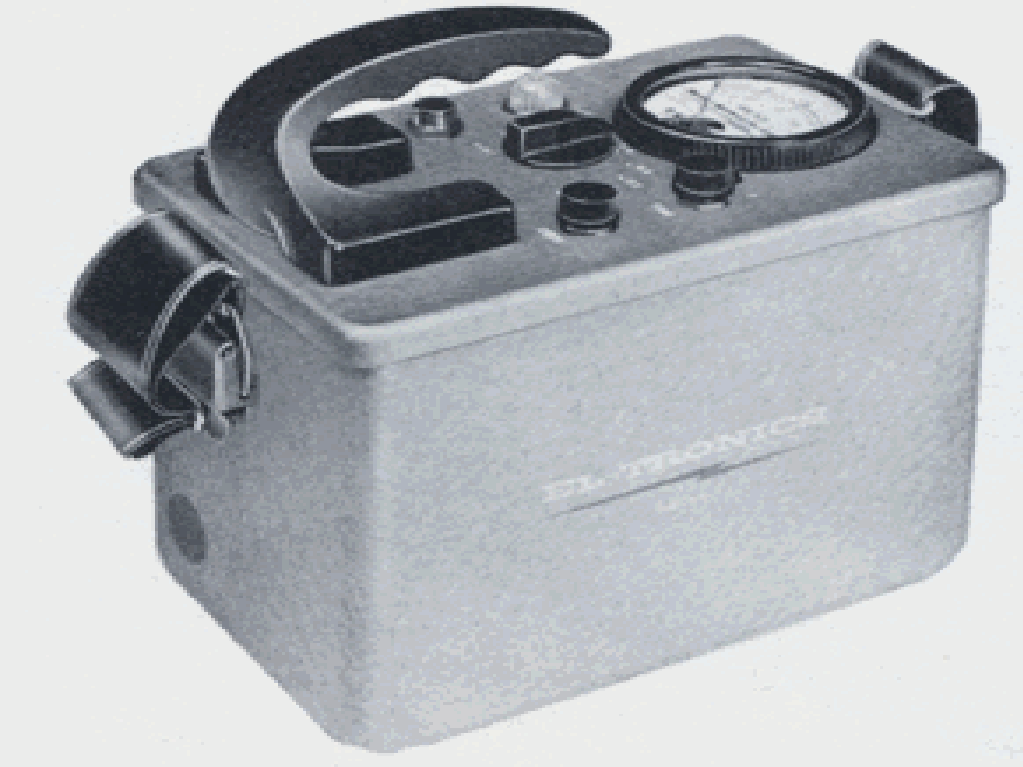
El-Tronics Model PR-30 1955
The Rad-Tek Model SID-1 was designed for use as a civil defense meter in 1954. It has an air ionization chamber for gamma detection. The meter gives a direct reading of radiation intensity. It has settings three settings from 0-0.5, 0-5 and 0-50 R/h. The ionization chamber is operated at 90 volts. The selector switch can be switched to the check battery scale which was a new feature for survey meters.
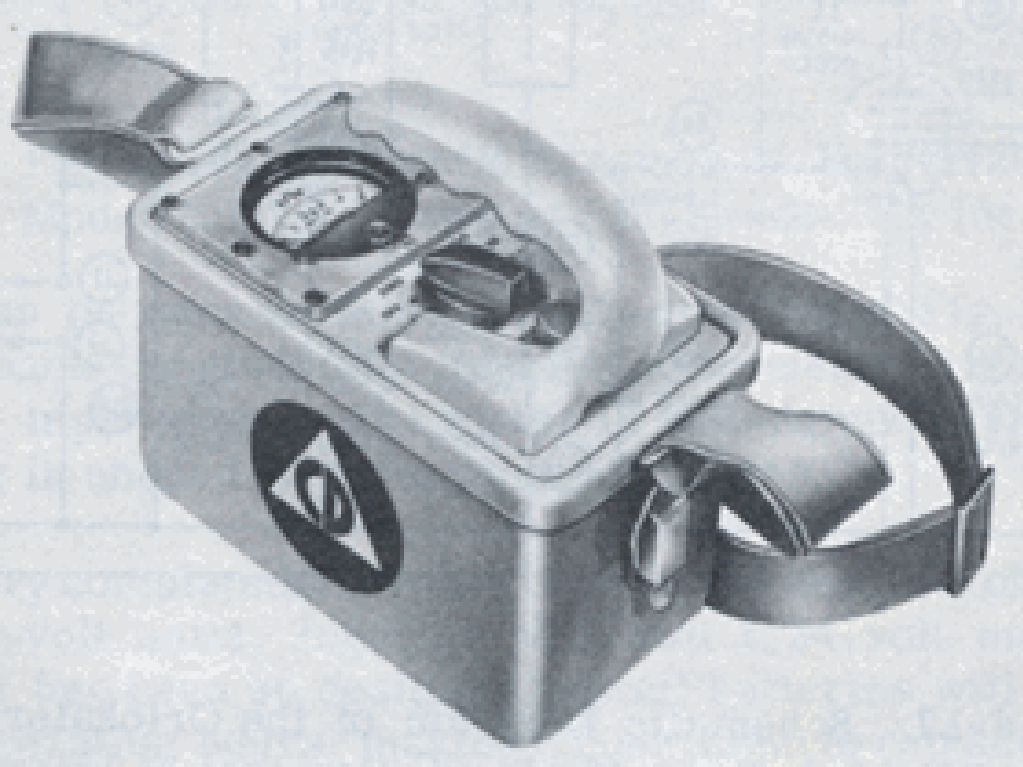
El-Tronics Rad-Tek Model SID-1 1954
The Model PR-31 was introduced in 1955. The ad states "Just set - aim - and read meter!". It was a super scintillation counter with a pistol type probe. It uses a massive 1” x 1.5” sodium iodide crystal. It can measure changes as small as 0.001 mR/h. It uses one 1.5 and two 67.5 volt batteries. The probe measures 3.5” tapering to 2.5” in diameter by 12” long. It has a blue hammertone case with black trim. The battery box measures 3.5” x 6” x 6.5” and weighs 10 lbs. 11 oz. The unit sold for $499.95.

El-Tronics Model PR-31 1955
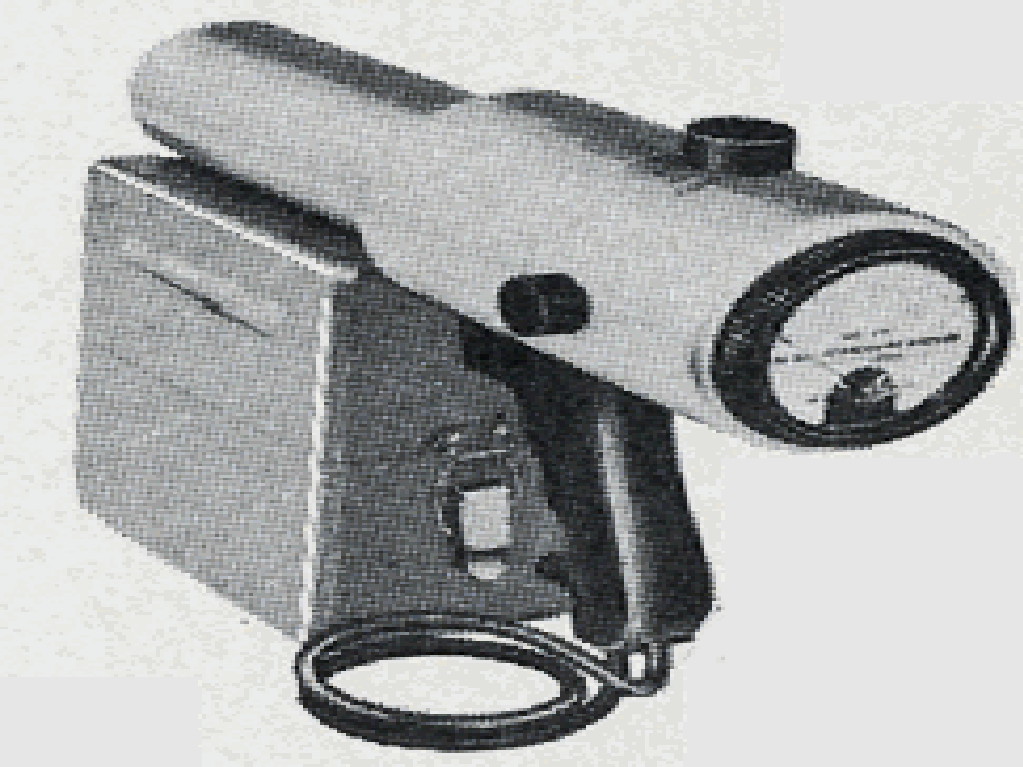
El-Tronics Model PR-31 Scintillator
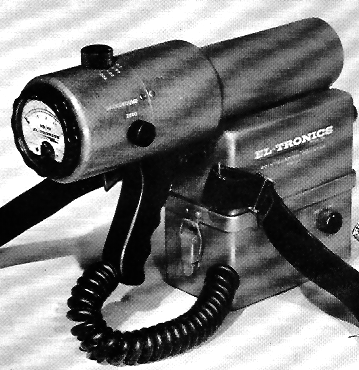
El-Tronics Model PR-31 1955 Scintillator
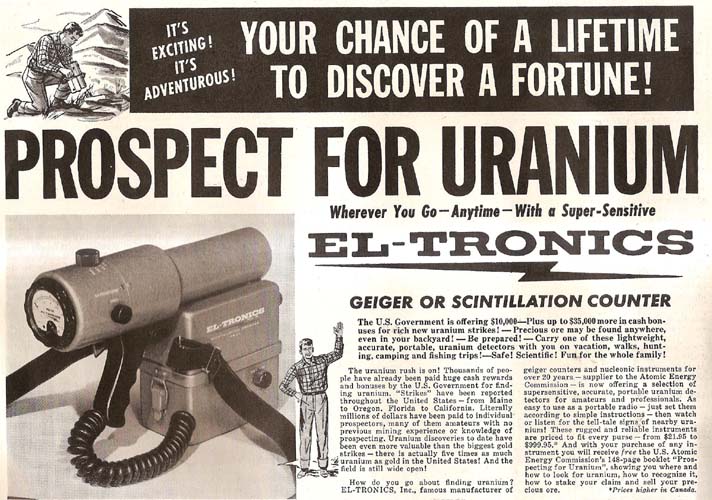
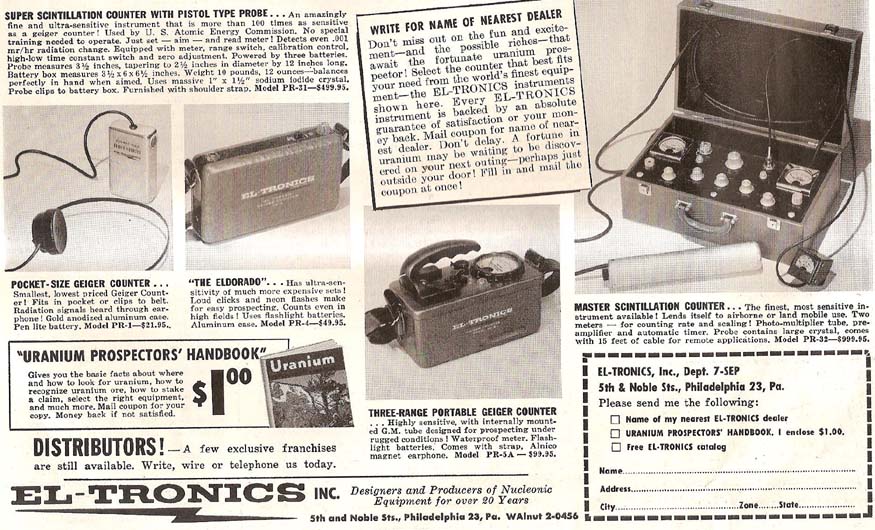
El-Tronics Ad from the Saturday Evening Post 1955
The Model PR-32 was a Master Scintillation Counter. It used a 2.5” sodium iodide detector. It came in a "beautiful brown cowhide covered strong wood box". The probe has a 15-foot cable for remote applications. It is especially useful for aerial or vehicle surveys where the probe needs to be outside the aircraft or vehicle. It has two large meters, one give the counting rate and the other gives the total counts. The unit sold for $999.95 in 1955. It weighs 28 lbs.
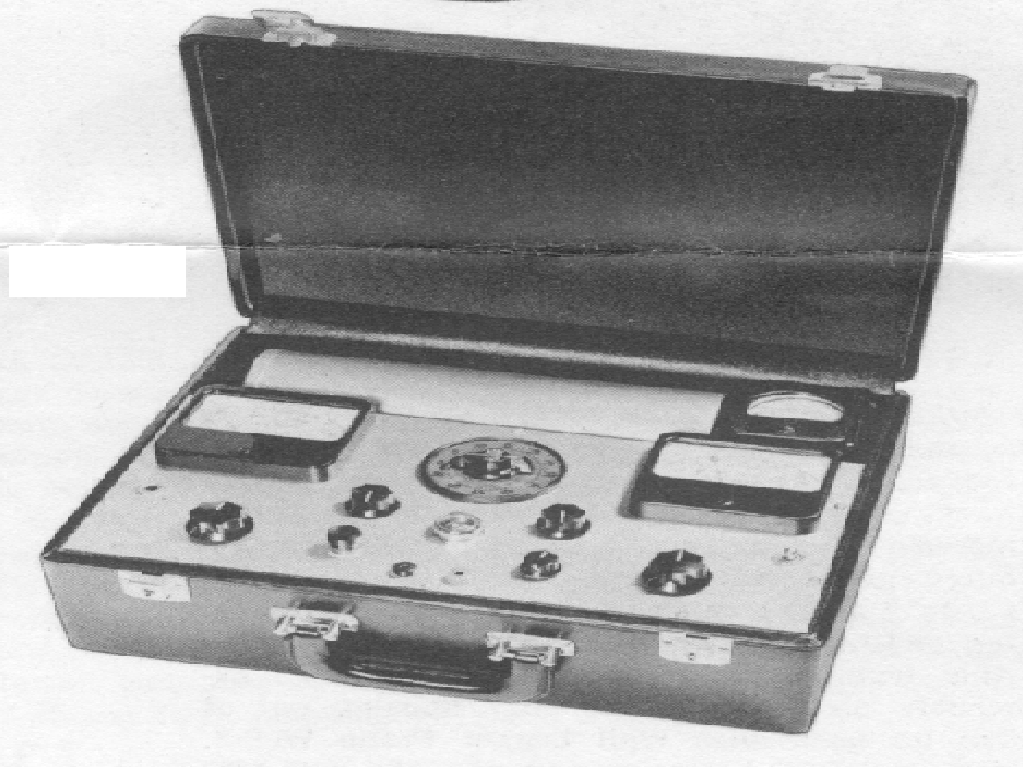
El-Tronics Model PR-32 1955
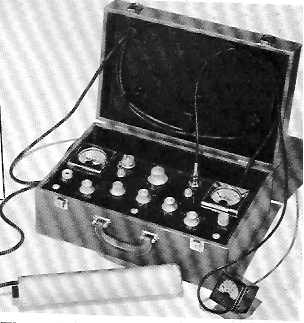
El-Tronics Model PR-32 1955
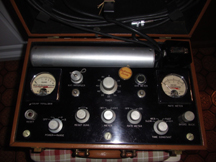
El-Tronics Model PR-32 1955
El-Tronics also produced several versions of the "Cutie Pie" style ionization chamber detectors for measuring high levels of radiation. The Cutie Pie beta gamma survey meter was introduced in 1951. It was a miniaturized light weight instrument with a range from 0-2500 mR/h. It had a splash-proof design. The unit weighed 4 lbs. It has a teflon range switch and chamber insulation to ensure calibration accuracy.

El-Tronics Cutie Pie 1951
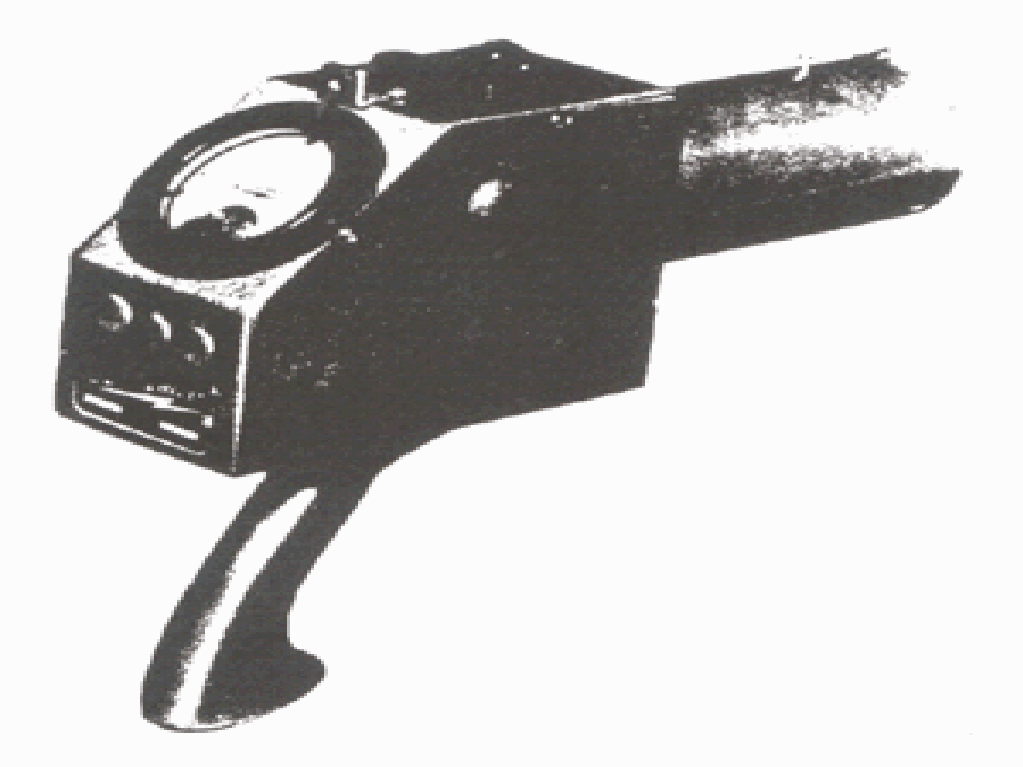
El-Tronics Hanford Model CP-2 1952
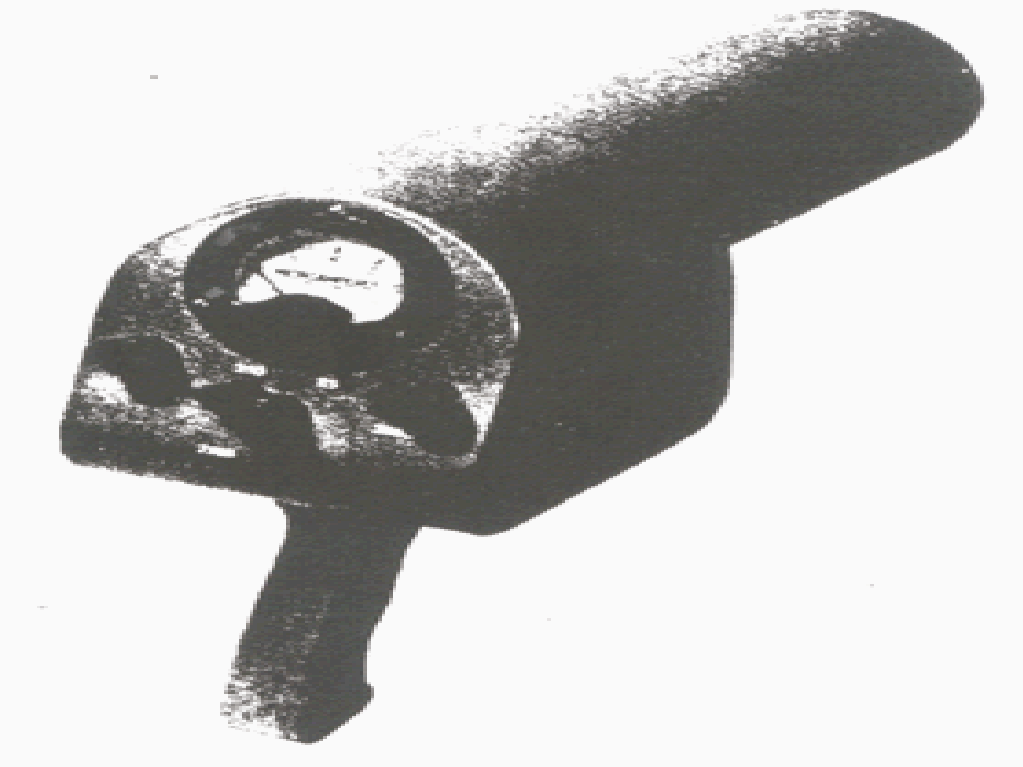
El-Tronics Model CP-3 1952
The Model CP-3A was introduced in 1952. It was a portable beta gamma survey meter with an ionization chamber. It could also detect alpha. The range was 100, 1000, and 10000 mR/h. The chamber was 3” diameter x 6” long. It was made of paper base with phenolic tubing coated with aquadag inside. It used teflon inside the chamber. For power it used four 22.5V and one 1.3V batteries. It was 10” x 3” x 8” and weighed 2.75 lbs.
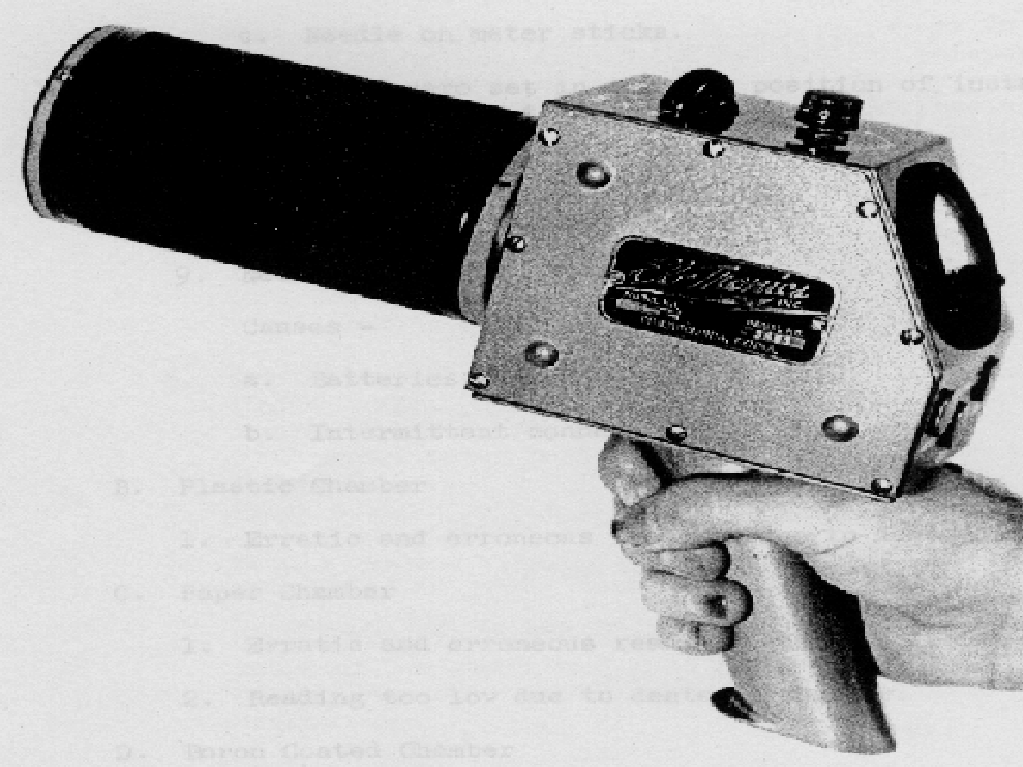
El-Tronics Oak Ridge Model CP-3A 1952
The PR-50 was introduced in 1951. It was an ionization chamber type survey meter. It was rugged, dependable and weighed 8 lbs. It had five ranges in distinctive colors from 0-50,000 mR/h on a large Navy sliding scale meter. Battery life is about 1000 hours.
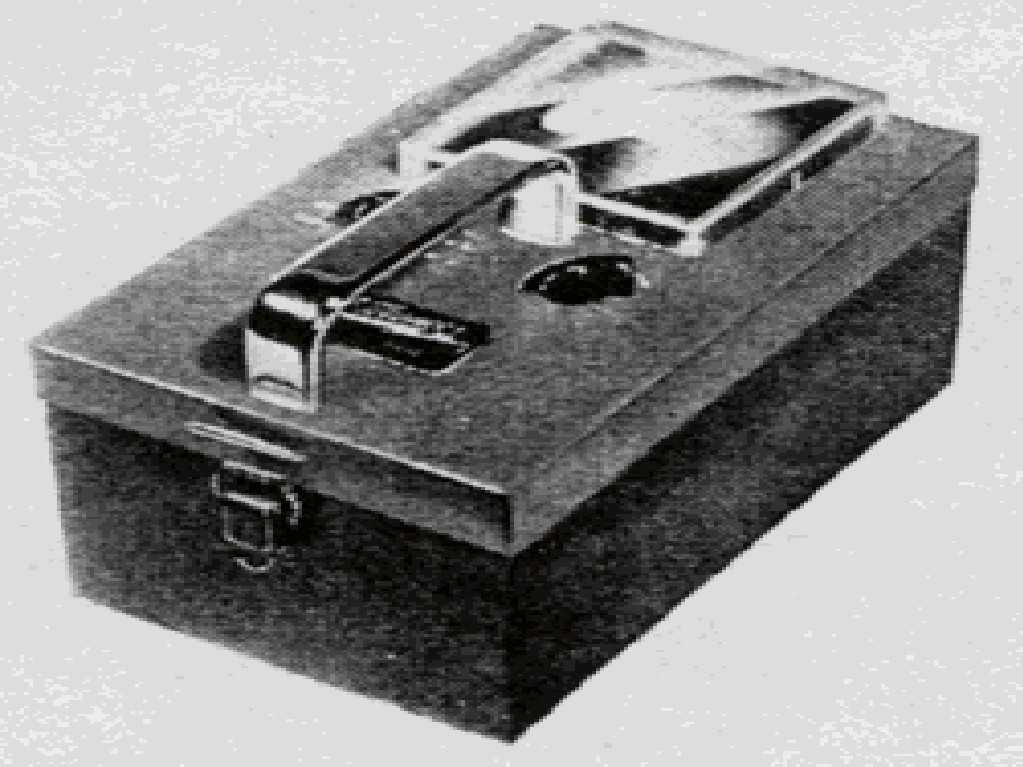
El-Tronics Model PR-50 1951
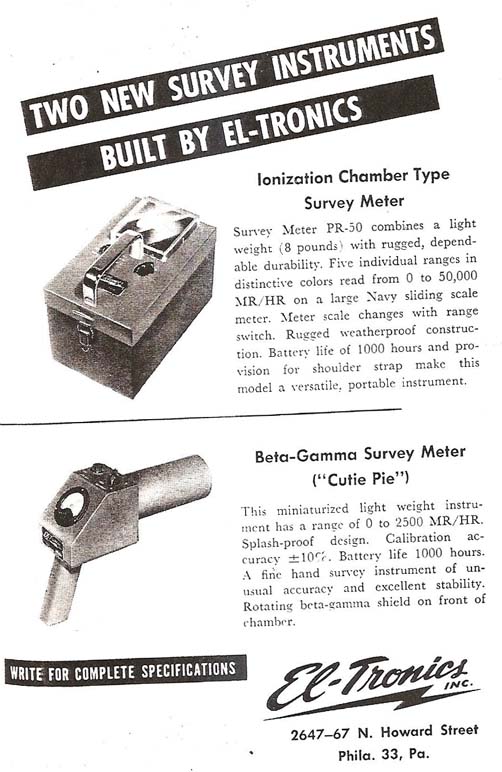
El-Tronics Model PR-50 1952
In 1955, El-Tronics offered a new line of eleven uranium prospecting instruments which included pocket size Geiger counters to the “Master Scintillation Counter”.
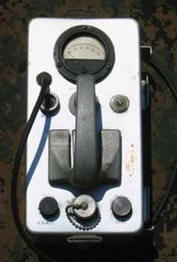
El-Tronics PAC-1 1950's
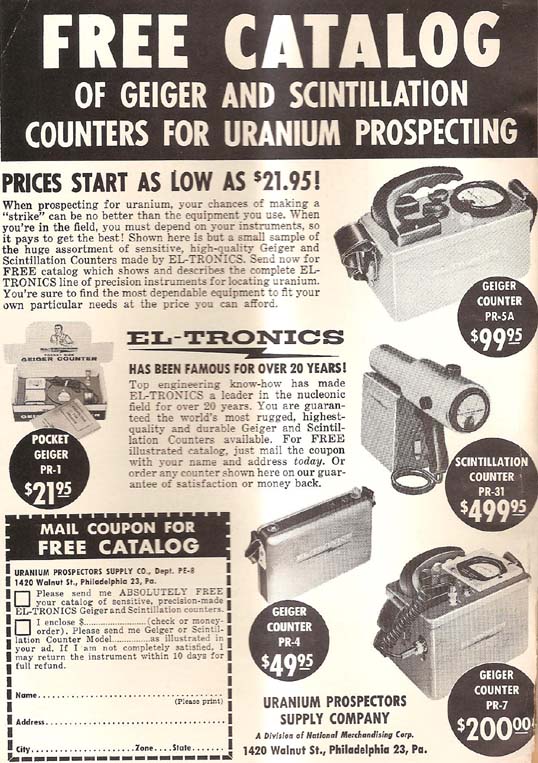
El-Tronics Ad 1955
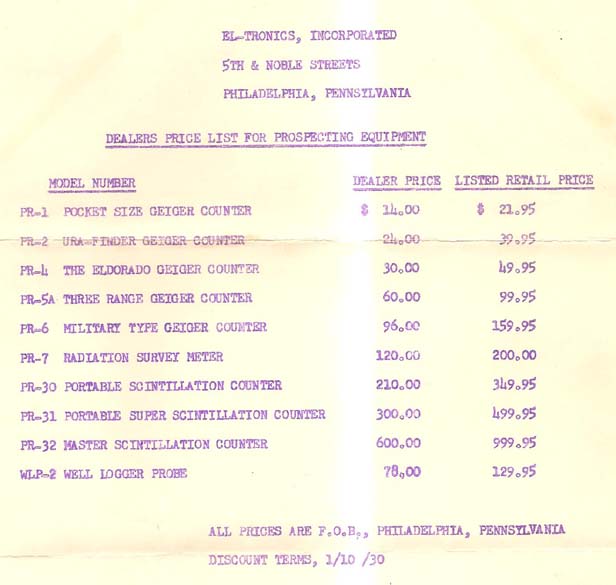
El-Tronics Price List 1955
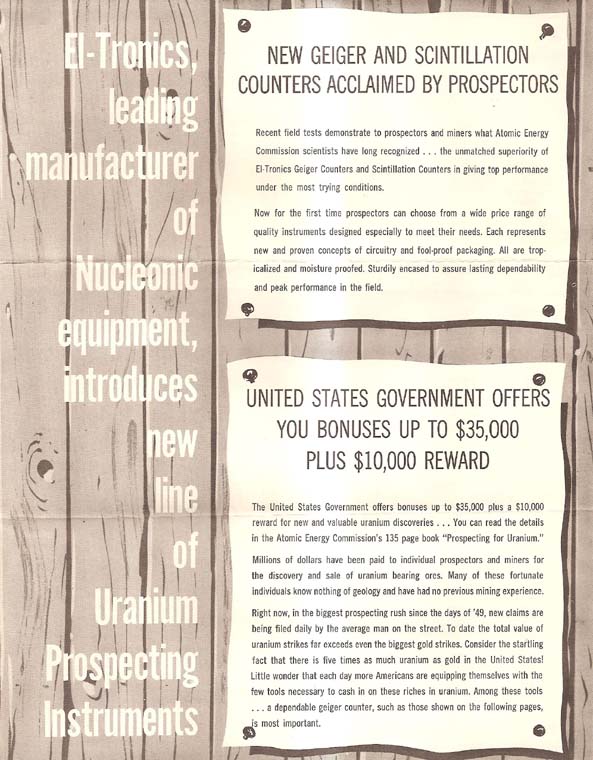
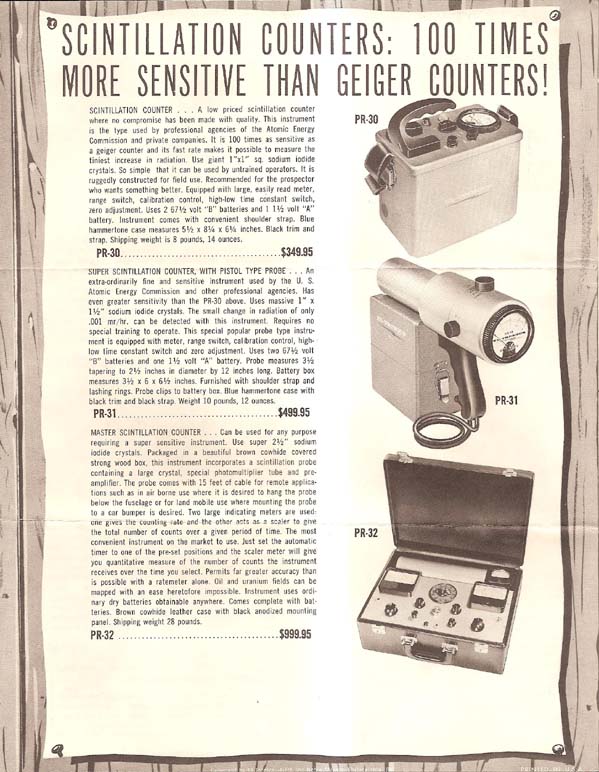
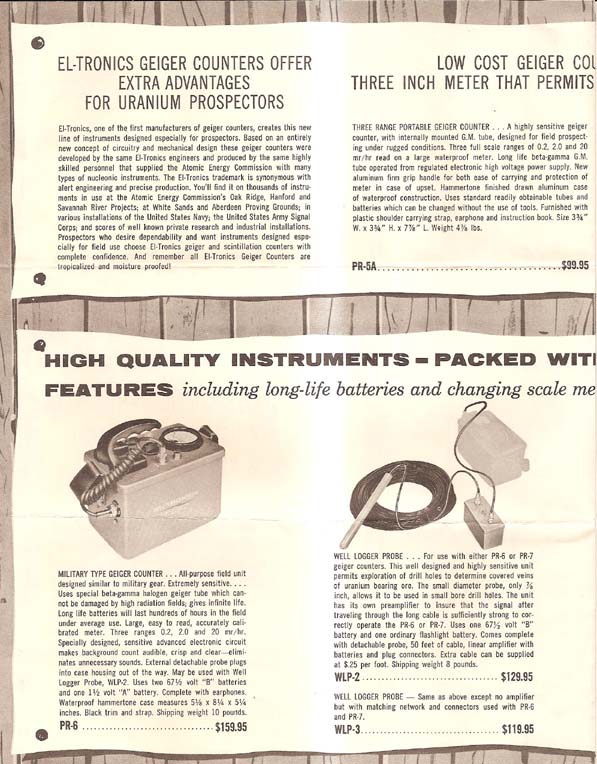
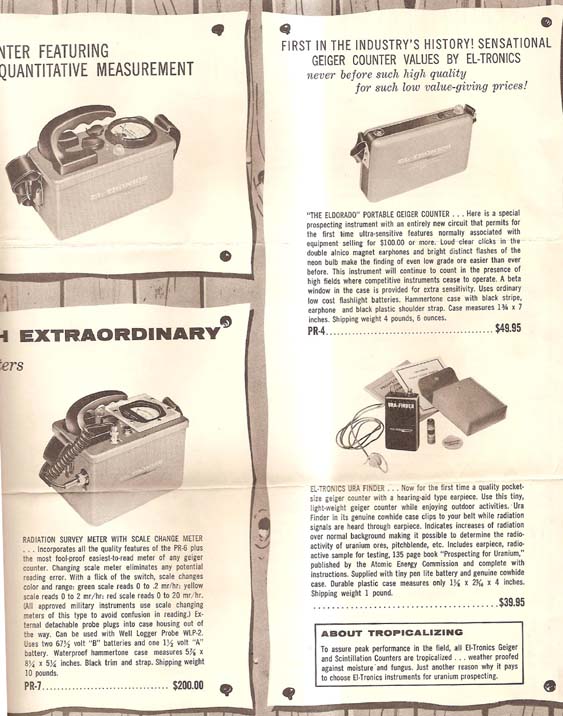
El-Tronics Ad 1950's